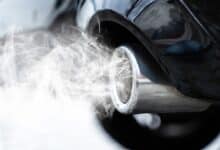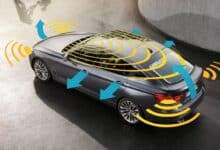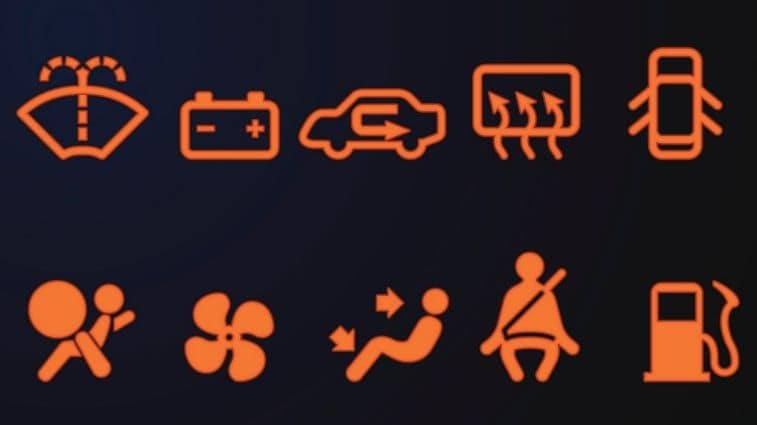Understanding Vehicle Warning Messages: What Do They Mean and How to Respond

Modern vehicles come equipped with an array of warning messages and indicators designed to communicate crucial information about the vehicle’s health and performance. “Understanding Vehicle Warning Messages What Do They Mean and How to Respond” is your comprehensive guide to deciphering these messages, empowering you to navigate the road with confidence and respond effectively to potential issues.
This guide is crafted to demystify the language of warning messages, offering insights into the significance of various symbols and alerts. From engine warnings to tire pressure indicators, we’ll explore the meanings behind these messages and provide practical guidance on how to respond.
Join us on a journey through the dashboard signals, understanding the difference between routine notifications and urgent warnings. Whether you’re a seasoned driver or a new car owner, this guide aims to be your go-to resource for interpreting vehicle warning messages, ensuring that you can address issues promptly and maintain your vehicle’s optimal performance. Let’s dive into the world of vehicle diagnostics, where knowledge empowers you to stay informed and in control on the road. Understanding car dashboard warning lights odern cars have dashboards packed with dials and an array of warning lights just waiting to switch on and confuse hapless drivers.
Usually, these warning lights aren’t a cause for concern, as they’ll go out once the engine’s running. But should they ever turn on during driving, you need to know what they mean, as some can indicate serious trouble.
The lights are coloured red, orange/amber or green, and work much like a traffic light system. Red is the equivalent of stop, and means the problem needs investigating immediately; orange or amber is an advisory signal, suggesting drivers will need to take action; and green says all is clear and serves as a helpful reminder.
Here’s a helpful guide to the most common dashboard warning lights.

Contents
- 1 Red dashboard warning lights – what do they mean?
- 2 Orange/amber dashboard warning lights – what do they mean?
- 2.1 9. Adaptive suspension dampers
- 2.2 10. Air suspension
- 2.3 11. Airbag warning light
- 2.4 12. ABS
- 2.5 13. AWD or 4WD
- 2.6 14. Brake pad monitoring
- 2.7 15. Broken bulb
- 2.8 16. Child safety lock
- 2.9 17. Convertible roof
- 2.10 18. Cruise control
- 2.11 19. DPF
- 2.12 20. Electronic throttle control
- 2.13 21. Engine management light
- 2.14 22. ESP
- 2.15 23. Glow plug light
- 2.16 24. Key not detected
- 2.17 25. Lane Keep Assist
- 2.18 26. Low fuel level
- 2.19 27. Rain and light sensor
- 2.20 28. Rear foglights
- 2.21 29. Rear windscreen heater
- 2.22 30. Traction control
- 2.23 31. Tyre pressure monitor
- 2.24 32. Warning light
- 3 Understanding Warning Symbols
- 4 Responding to Warning Messages
- 5 Preventive Measures to Avoid Warning Messages
- 6 When to Seek Professional Help
- 7 Decoding Signals: Understanding Vehicle Warning Messages – What They Mean and How to Respond
Red dashboard warning lights – what do they mean?
1. Airbag warning lightThis red light may appear to be a picture of a passenger balancing a beachball on their lap, but it means that one of the airbags is malfunctioning. This is a serious matter, as it could fail to inflate in the event of an accident, or worse still, inflate without warning while you’re driving. |
|
2. Brake system lightThe first thing to do if you see this symbol glowing on the dashboard is check the handbrake hasn’t been left on. Assuming it hasn’t, there is a fault with the brake system. That could relate to the worn condition of the brake pads or discs, a lack of fluid in the system or a problem with the anti-lock brakes (ABS) or stability control (ESP). Have it investigated by a garage as soon as possible. |
 |
3. Engine cooling systemTo keep their cool, nearly all cars pump coolant fluid around their engines. If this warning light turns on, that coolant level could be dangerously low, or a blockage in the system could be causing the engine to overheat. Call out your breakdown provider or seek immediate assistance at the nearest garage. |
 |
4. Engine oil pressureThis generally tells drivers that the engine has lost oil pressure or is crying out for a top-up of oil. If you can’t remember the last time you checked the oil level, or had it changed at a garage, there’s a good chance it’s now at a dangerously low level – which could cause serious damage. So pull in to the nearest petrol station or garage, consult the vehicle handbook and check the engine’s oil level. The handbook will advise which type of oil is needed for a top-up. |
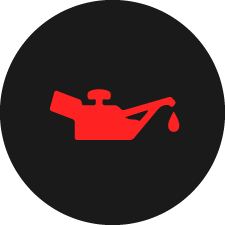 |
5. Power steering systemMost of us would struggle to turn a steering wheel if a car didn’t have what’s known as power assistance. This is a hydraulic or, increasingly, electric pump that helps turn the steering. So when the warning light for the system illuminates, take it seriously and have it checked out by a professional. |
 |
6. Vehicle charging systemThe most likely cause of a red light with a battery symbol is that the car battery is no longer charging, or something is draining the charge when the car is parked and switched off. A flat battery is one of the most common causes for breakdown technicians being called out. So if the light comes on, your car will need further examination. |
 |
7. Steering lockUsually, an amber steering lock symbol will indicate that the car’s steering lock needs to be released before the engine can be started. But if it remains red after starting the motor, it suggests there is a malfunction with the mechanism. In that case, don’t switch off the engine and head to a garage to have it inspected. |
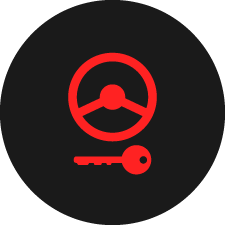 |
8. Ignition switchWith myriad electronic systems involved in the smooth running of the modern car, the ignition switch warning symbol could indicate all manner of maladies. So have the car checked over as soon as is practically possible. |
 |
Orange/amber dashboard warning lights – what do they mean?
9. Adaptive suspension dampers |
|
| Certain cars have sophisticated dampers in their suspension system, which can be set to be softer or firmer. If you see this warning sign, then the dampers will need checking. |  |
10. Air suspension |
|
| Plenty of posh cars come with air suspension systems. The appeal is that they allow drivers to tailor the driving experience, to an extent. This light can either indicate that you’ve left the air suspension in a raised setting, or there’s a glitch in the system. |  |
11. Airbag warning light |
|
| An amber airbag warning light usually signals that the front passenger side airbag has been switched off by the driver – such as when installing a rear-facing child seat in the front chair. |  |
12. ABS |
|
| Anti-lock brakes (ABS) are one of the greatest strides in making driving safer. They allow a driver to apply maximum braking and steer at the same time, such as when trying to avoid a pedestrian stepping out into the road. If the ABS warning light comes on, it means there is a malfunction with the system, and drivers should have it investigated. |  |
13. AWD or 4WD |
|
| In cars that have a selectable four-wheel drive system, this light appears once the driver has chosen to switch from two to four-wheel drive operating mode, simply confirming their choice. |  |
14. Brake pad monitoring |
|
| Brake pads and discs wear out. This is your handy reminder to have them serviced. |  |
15. Broken bulb |
|
| Headlamp or brake lamp bulbs fail from time to time. This helpful warning symbol will act as a challenge: do you try and replace the bulb yourself? Or pay a garage to put things right? |  |
16. Child safety lock |
|
| An increasing number of cars now offer an electronically controlled child safety lock for the back doors. It saves drivers from fiddling around with catches, and once the symbol is illuminated, it’s simply confirming that the back doors can’t be opened from inside of the car. |  |
17. Convertible roof |
|
| When this illuminates, it tells drivers of drop-top cars that an obstruction or more serious fault could be preventing the roof from opening or closing. |  |
18. Cruise control |
|
| There are various types of cruise control these days, with passive versions that maintain a set speed, active systems which vary a car’s speed according to traffic conditions, and some that can even respond to changes in speed limits. The cruise control warning sign usually signifies that you’ve turned on the system. |  |
19. DPF |
|
| A Diesel Particulate Filter (DPF) is an essential bit of kit that captures many of the nasty toxic particles that come from burning diesel fuel. The warning light can signal that the car’s DPF needs to be cleaned out, a process which can involve taking the car on an extended high speed run. Or there may be a more serious problem, which can cause cars to fail the MOT’s emissions test. |  |
20. Electronic throttle control |
|
| It’s dangerous to have a faulty accelerator. What if it stops sending a signal to the engine to accelerate? Or worse, it sends the wrong signal and causes unintended acceleration? So if this warning light comes on, have it investigated immediately. |  |
21. Engine management light |
|
| So much of a modern car is controlled by computer, and at the heart of such control systems is the engine management system. If the warning light comes on, the car will still function, but could possibly switch into what’s known as a ‘limp home’ mode with reduced performance. Have it checked out, pronto. It could indicate problems with the emissions control systems. |  |
22. ESP |
|
| Your car’s Electronic Stability Programme (ESP, or sometimes ESC) is what keeps it securely planted on the road. It’s an important bit of kit, but sometimes drivers may turn it off. The warning symbol serves as a reminder. But if you haven’t switched it off and the light comes on, there’s a fault which requires further checks. |  |
23. Glow plug light |
|
| Glow plugs help start a diesel engine when it’s cold. So if you drive a diesel-powered car, you should wait for the glow plug symbol to switch off before starting the engine. However, if they come on after this, it means one of the glow plugs has a problem – common, as they wear out over time. |  |
24. Key not detected |
|
| Many cars no longer need a key in the traditional sense. Instead, they use a ‘smart key’ which is meant to be more convenient. If you unlocked your car and started it, then popped back into your house, accidentally leaving your smart key on the kitchen table when you did, this is your helpful reminder not to drive off without the ‘key’. |  |
25. Lane Keep Assist |
|
| Some cars have Lane Keep Assist to help steer themselves back into the lane of a road if they detect that the vehicle is wandering too close to a white road marking or verge. This symbol indicates that the system is active. A red symbol means the system is faulty. |  |
26. Low fuel level |
|
| Every driver is likely to have seen this at least once. It means the car’s fuel tank is nearly empty and if you don’t put more fuel in, you’ll be grinding to a halt fairly soon – usually somewhere between 20 and 50 miles. |  |
27. Rain and light sensor |
|
| Automatic lights and windscreen wipers are becoming increasingly common on new cars. If this warning light appears, it’s telling you there’s a problem with one of them. |  |
28. Rear foglights |
|
| Been driving in fog, and forgotten to turn off your car’s rear foglights? That’s what this symbol is there for, reminding drivers to switch off foglights. |  |
29. Rear windscreen heater |
|
| This is an easy one. It means the car’s rear windscreen heater is on. Switch it off once you can see clearly out of the back. |  |
30. Traction control |
|
| When you see an orange symbol of a car leaving skid marks on the road, it can mean one of three things. If it flashes briefly, it’s simply telling the driver that the traction control system is doing its job and preventing wheelspin. If you have chosen to switch off the traction control, the light will remain on as a reminder that the system is inactive. But if it has turned on of its own accord, there is a problem with the traction control system which will need checking out. |  |
31. Tyre pressure monitor |
|
| Most modern cars come with a system that keeps a watchful eye over the air pressure in the tyres. If it detects that one has fallen noticeably compared with the others, it will warn the driver. If your’e on the road, head for a petrol station and check the pressures and adjust accordingly. If your’e unsure on how to reset the tyre pressure monitor, the vehicle handbook will offer a step-by-step guide. |  |
32. Warning light |
|
| The yellow triangle with an exclamation mark will typically be accompanied by a message explaining what’s gone wrong. Hopefully it will be self-explanatory – such as a low reservoir for the windscreen washer system. |  |
Understanding Warning Symbols
Modern vehicles are equipped with a range of sensors and diagnostic systems that can detect malfunctions and abnormalities. When an issue is detected, a warning symbol will appear on the dashboard to get the driver’s attention. These symbols are usually universal, but it’s important to consult your vehicle’s manual for precise meanings.
Common Warni1ng Symbols and Their Meanings:
- Check Engine Light: This is one of the most common warning symbols and indicates a problem with the engine or its related components. It could be as simple as a loose gas cap or as serious as a malfunctioning sensor.
- Battery Warning Light: This symbol indicates an issue with the vehicle’s charging system. It could be a faulty alternator, a loose belt, or a weak battery.
- Oil Pressure Warning Light: This symbol alerts the driver about low oil pressure. It could be due to a leak, low oil levels, or a faulty oil pump.
- Brake System Warning Light: This symbol indicates a problem with the braking system. It could be due to worn brake pads, low brake fluid levels, or a malfunctioning ABS system.
- Tire Pressure Monitoring System (TPMS) Warning Light: This symbol alerts the driver about low tire pressure. It could be due to a puncture, leaky valve stems, or temperature changes.
See more: The Benefits of the ABS Braking System: Ensuring Safety and Efficiency on the Road
Responding to Warning Messages
When a warning message appears on your vehicle’s dashboard, it’s important not to ignore it. Ignoring warning messages can lead to further damage or even accidents. Here are some steps to effectively respond to warning messages:
Step 1: Don’t Panic
Seeing a warning message can be unsettling, but it’s important to stay calm and composed. Panicking can impair your ability to think clearly and respond appropriately. Take a deep breath and focus on finding a safe place to pull over if necessary.
Step 2: Identify the Warning Symbol
Take a moment to identify the specific warning symbol that appeared on the dashboard. Refer to your vehicle’s manual if you’re unsure about its meaning.
Step 3: Assess the Severity
Some warning symbols indicate minor issues, while others signify more severe problems. Assess the severity based on the symbol and any accompanying sounds or behaviors of the vehicle.
Step 4: Take Immediate Action (If Required)
If the warning symbol indicates that immediate action is necessary for safety reasons, such as the brake system warning light, pull over to a safe location and call for roadside assistance or a mechanic. Avoid driving the vehicle until the issue is resolved.
Step 5: Consult Your Vehicle’s Manual
Refer to your vehicle’s manual for specific instructions on how to address the issue indicated by the warning message. It may provide troubleshooting steps or recommend contacting a professional for assistance.
Step 6: Schedule an Inspection/Repair
Regardless of the severity indicated by the warning message, it’s always wise to schedule an inspection or repair as soon as possible. Even minor issues can escalate if left unattended.
A Comprehensive Guide to Checking and Changing the Coolant in Your Vehicle
Preventive Measures to Avoid Warning Messages
While warning messages are inevitable in some cases, there are preventive measures you can take to minimize their occurrence:
Regular Vehicle Maintenance:
Follow your vehicle manufacturer’s recommended maintenance schedule. Regularly checking and replacing fluids, filters, and worn-out components can help prevent issues that trigger warning messages.
Proper Tire Maintenance:
Maintain proper tire pressure and inspect your tires regularly for wear and tear. A well-maintained tire reduces the chances of encountering tire-related warning messages.
Avoid Ignoring Minor Issues:
Address minor issues promptly before they escalate into more significant problems. For example, if you notice a slight vibration or unusual noise, have it checked by a professional rather than waiting for a warning message to appear.
Safe Driving Practices:
Adopt safe driving practices such as avoiding sudden acceleration or braking, observing speed limits, and being mindful of road conditions. By driving responsibly, you can reduce the risk of encountering warning messages related to sudden system failures.
When to Seek Professional Help
While some warning messages can be resolved through basic troubleshooting or quick fixes, there are situations where seeking professional help is essential:
- When the warning message persists even after following troubleshooting steps.
- When the warning symbol indicates a critical issue such as engine overheating or brake failure.
- When you’re unsure about how to address the issue indicated by the warning message.
- When you lack the necessary tools or expertise to diagnose and fix the problem.
Decoding Signals: Understanding Vehicle Warning Messages – What They Mean and How to Respond
Vehicle warning messages should never be taken lightly. They serve as crucial indicators of potential issues in your vehicle’s systems that require attention. By understanding these warning messages, responding appropriately, and practicing preventive measures, you can ensure your safety on the road and avoid costly repairs in the long run. Remember, when in doubt, consult with a professional mechanic who can provide expert advice and assistance. Stay alert, stay safe!
See more at: Car Care Vip




